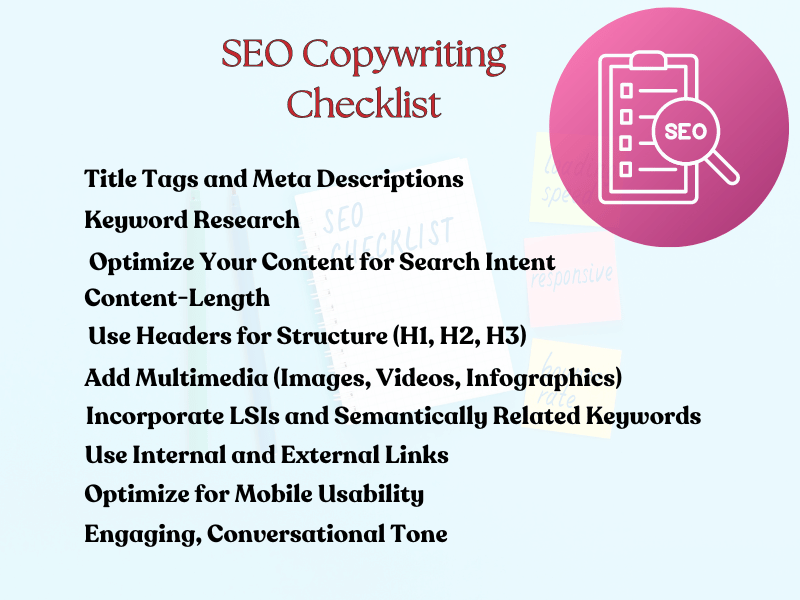SEO copywriting is a specialized form of writing designed to improve a website’s visibility in search engine results while engaging readers. It combines keyword optimization, content quality, and user experience to attract traffic, retain visitors, and drive conversions.
Whether you’re a business owner, digital marketer, or content creator, this guide breaks down every step you need to write content that’s not only reader-friendly but also optimized to climb up the search engine results pages (SERPs).
Why You Need an SEO Copywriting Checklist
It’s easy to miss crucial steps when writing content, especially when juggling creativity and SEO requirements. A well-structured checklist ensures you cover everything—making your content more appealing to both users and search engines.
If you’re producing content for digital marketing, make sure to avoid common pitfalls like those mentioned in SEO Mistakes in Digital Content Production: Easy Fix.
SEO Copywriting Checklist: The Key Steps
1. Keyword Research: Know What People Are Searching For
Start with in-depth keyword research. Your content should focus on primary and secondary keywords that match your audience’s search intent.
- Use tools like Google Keyword Planner, SEMrush, or Ahrefs.
- Identify primary keywords with high search volume and relevance.
- Sprinkle in long-tail keywords to target more specific queries.
Pro tip: For local businesses, consider including Is local SEO dead? in your keyword strategy.

2. Title Tags and Meta Descriptions
Your title tag is the first thing people see in search results, so make it count. The meta description helps convince people to click on your link.
- Title tag: Include your primary keyword and keep it under 60 characters.
- Meta description: Add your primary keyword and a call-to-action in 155–160 characters.
Example:
- Title: SEO Copywriting Checklist: Proven Tips to Boost Rankings
- Meta Description: Learn how to write SEO-friendly content with this ultimate copywriting checklist. Improve your rankings and get more traffic today!
3. Use Headers for Structure (H1, H2, H3)
Headers aren’t just for readability—they’re also for SEO. Ensure you follow a logical order for headers.
- H1: Main keyword (e.g., “SEO Copywriting Checklist”).
- H2: Use secondary keywords for subheadings (e.g., “How to Optimize Content for SEO”).
- H3: Break down complex topics (e.g., “Why Keywords Matter in SEO”).
4. Optimize Your Content for Search Intent
Google favors content that answers user questions and provides valuable information. Make sure your content is customized to solve real problems.
- Write for people first, not search engines.
- Ensure the content fulfills the searcher’s intent, whether it’s informational, navigational, or transactional.
Check out What to Ask an SEO Consultant for more insights into hiring the right SEO expert.
5. Use Internal and External Links
Internal links help with site navigation and boost SEO by spreading link equity across your pages. External links to authoritative sources also improve credibility.
- Add relevant internal links. For example, internal links like my other SEO Plan for 3 Months or SEO Speaker articles can be used as my internal links for this blog.
- Link out to trusted external resources to back up claims and enhance authority.
For improving on-page SEO, read How Do You Build Discovery and Relevance for Search Engines?.
6. Content-Length: Write Enough to Cover the Topic
There’s no magic word count, but longer, more comprehensive articles tend to perform better in search results. Aim for at least 1,500 words for in-depth topics like SEO copywriting.
7. Optimize for Mobile Usability
With the majority of traffic coming from mobile devices, your content should look just as good on a phone as it does on a desktop.
- Use responsive design.
- Break up content with headers, bullet points, and short paragraphs for easier reading on mobile.
8. Add Multimedia (Images, Videos, Infographics)
Visual elements can increase engagement and make your content more shareable. Google also takes multimedia into account when ranking pages.
- Optimize images with alt text that includes your target keywords.
- Compress images to ensure fast loading times.
9. Write in an Engaging, Conversational Tone
Skip the jargon and speak directly to your audience. Your writing should feel like you’re explaining SEO strategies to a friend over coffee.
- Avoid fluff and filler content.
- Keep sentences and paragraphs short.
If you’re outsourcing content creation, consider Why Outsource Search Engine Optimization? for guidance on whether it makes sense for your business.
10. Incorporate LSIs and Semantically Related Keywords
Don’t just stuff your content with the primary keyword. Use Latent Semantic Indexing (LSI) keywords and related terms naturally to cover more SEO ground.
For instance, if you’re writing about SEO copywriting, include terms like “on-page SEO,” “meta tags,” and “search engine optimization.”
Data Insights to Strengthen Your SEO Copywriting
- Akamai Study: A study by Akamai, a global leader in content delivery network (CDN) solutions, found that 40% of users abandon a website if it takes longer than 3 seconds to load.
- Clear Content Structures: Research shows that organized content with headings and bullet points reduces bounce rates and improves user engagement.
- Search Intent Alignment: Pages that match user intent rank higher, demonstrating the importance of addressing specific needs through targeted content.
FAQs About SEO Copywriting
1. What is SEO Copywriting?
SEO copywriting is the art of writing content that is both valuable to readers and optimized for search engines. It involves using relevant keywords, structuring content properly, and ensuring the content aligns with search intent. Here’s how to become a SEO copywriter with no experience in just 6 steps.
2. How Often Should You Update SEO Content?
SEO is ever-changing, so it’s important to update your content every 3–6 months to reflect new trends, keyword shifts, and Google algorithm updates.
3. Does Keyword Density Still Matter?
Yes, but keyword stuffing is a thing of the past. Focus on naturally incorporating your keywords where they make sense. Use related terms and phrases to boost relevance.
Conclusion: Your Path to SEO Success
By following this SEO copywriting checklist, you’ll create content that’s not only optimized for search engines but also offers real value to your readers. From keyword research to optimizing for mobile usability, each step is crucial for ensuring your content ranks higher and engages your audience.
SEO copywriting doesn’t have to be complicated—start with this checklist, and you’ll be well on your way to success.
Remember: Quality content comes first. Rankings will follow naturally.
